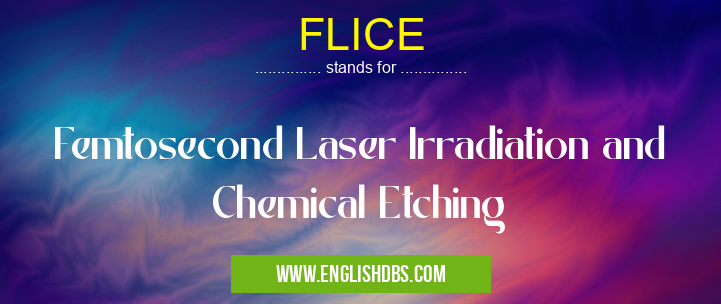What does FLICE mean in CHEMISTRY
Femtosecond Laser Irradiation and Chemical Etching (FLICE) is a multi-step process used to create nano-scale features on the surfaces of materials. It combines femtosecond laser pulses with chemical etching to achieve incredible levels of accuracy, precision, and control. FLICE has opened up new possibilities for researchers and manufacturers alike who are looking to create nanostructured solutions for products ranging from solar cells to medical implants.

FLICE meaning in Chemistry in Academic & Science
FLICE mostly used in an acronym Chemistry in Category Academic & Science that means Femtosecond Laser Irradiation and Chemical Etching
Shorthand: FLICE,
Full Form: Femtosecond Laser Irradiation and Chemical Etching
For more information of "Femtosecond Laser Irradiation and Chemical Etching", see the section below.
Process Description
FLICE combines two processes to achieve the desired results. The first step is femtosecond laser irradiation which produces ultra-short pulse durations lasting only 10^-15 seconds, greatly increasing energy efficiency while minimizing heat buildup in the material being worked on. This process selectively ablates material on the surface of the workpiece without significantly affecting deeper layers below it. The second step involves chemically etching those ablated areas away. This can be done either by exposing the substrate to acidic or caustic chemicals or by flowing a gas containing atoms of an appropriate chemical species such as oxygen or chlorine across it. Utilizing both processes allows for incredible detail down to nanoscale resolutions with great precision and accuracy.
Applications
FLICE is an incredibly versatile technique as its possible applications are wide ranging. For instance, it has been used to fabricate nanostructured solar cells which have increased light absorption capabilities and enhanced performances, while also reducing manufacturing costs significantly compared to other more traditional techniques such as photolithography or electron beam lithography. Additionally, FLICE has been employed in creating microfluidic devices for biomedical uses such as drug delivery systems or microscopic tubes for transporting fluids within these devices. It also offers significant advantages when it comes to making three dimensional structures as well as creating patterns on highly curved surfaces such as those present inside medical implants like stents or implants placed inside living tissue such as pacemakers or artificial eyes.
Essential Questions and Answers on Femtosecond Laser Irradiation and Chemical Etching in "SCIENCE»CHEMISTRY"
What is Femtosecond Laser Irradiation and Chemical Etching (FLICE)?
FLICE is a combination of two different techniques that are used to produce nanostructured materials. It involves the use of laser radiation to break down molecules into smaller particles, followed by the application of specialized chemical etching processes to further shape those particles into desired shapes and morphologies.
How do FLICE techniques help create nanostructured materials?
By using femtosecond laser irradiation, an extremely short duration of laser light is produced which can be used as a "tool" to break up molecules into very small pieces. Chemical etching uses chemical reactions to further refine those pieces into desired shapes and structures, allowing for the creation of intricate nanostructured materials with precise control over size and shape.
Is FLICE an expensive technique?
While it does require specialized equipment and knowledge in order to achieve the desired results, FLICE is not necessarily overly expensive when compared to other methods used for creating nanostructures. By careful planning, optimization and cost-savings measures during fabrication, it can often be achieved without putting an excessive strain on research budgets.
What types of materials can be made using FLICE?
Through careful design and implementation of FLICE techniques, almost any type of material can be formed into incredibly small structures at the nanoscale level including metals, semiconductors, polymers and other composites, ceramic monoliths as well as complex layered structures.
What advantages does FLICE offer over traditional manufacturing techniques?
The main advantage that FLICE offers is its ability to produce incredibly small structures with precise dimensions that would otherwise be difficult or impossible with traditional manufacturing processes. There is also greater control over surface features such as roughness and porosity due to the use of laser irradiation which allows for more efficient utilization of resources.
How long does it take to go through a full cycle of FLICE production?
Depending on the complexity requirements for the material being formed as well as other factors such as available resources and environmental constraints, it typically takes anywhere from several hours up to several days or even more for a complete cycle.
What kind of parameters must be taken into account when designing a process involving FLICE?
When designing any process involving FLICE it's important to consider several parameters such as production rate expectations, achievable surface features within tolerances, throughput requirements related with input materials as well as energy usage levels throughout various stages.
Are there any potential risks associated with using this type of technology?
Although there are potential risks associated with any type or form of technology that involves manipulation at a nanoscale level (such as improper handling or disposal), these risks can generally be minimized by taking necessary precautions such proper training on operating protocols or adequate safety protocols in place.
What areas are most suited for implementing FLICE technologies?
Areas related with tissue engineering where complex layers should be formed in order for 3D printing; membrane formation; drug delivery systems; microfluidic devices; electronic components such sensors; photovoltaics cells; light emitters etc.
Final Words:
In conclusion, Femtosecond Laser Irradiation and Chemical Etching (FLICE) is a powerful tool that enables researchers and manufacturers alike to make unprecedentedly detailed nano-structures through a combination of laser irradiation and chemical etching processes performed with extreme precision, accuracy, and control over resulting features’ size down into the nanoscale resolution regimes. Its use in products ranging from solar cells to medical implants has opened up new possibilities that weren’t available only a few years ago due its versatility and cost effectiveness when compared with other production methods like photolithography or electron beam lithography.
